/Vehicles/Axis/Germany/03-sPanzers/PzKpfw6-Tiger2/File/3-Design-bis.htm | Last Up-date:
Panzerkampfwagen VI Tiger II Heavy Tank
Design: Engine Compartment
Ce compartiment accueillait bien entendu en son centre le moteur Maybach HL 230 P30 (V12) développant 700ch à 3000t/m. Ce moteur à l'origine conçu pour le Panther (45 tonnes) permettait au Tigre II (70 tonnes) d'atteindre en théorie sur route la vitesse de 42km/h. Un tel usage était cependant fort déconseillé en raison d'une surchauffe inévitable. Comme il n'existait pas de moteur spécifique pour le Tiger II, ce dernier fut équipé de ce moteur pas vraiment adapté et le Tigre-Royal était en vérité sous-motorisé. De plus le conflit évident entre la puissance du moteur et le poids de l'engin engendrait de nombreux problèmes de fiabilité. quant on sait que ce moteur suffisait à peine au Panther.
This compartment of course accomodated in its center the engine Maybach HL 230 P30 (V12) developing 700hp to 3000rpm. This engine at the origin conceived for the Panther (45 tons) made it possible Tiger II (70 tons) to reach in theory on road the speed of 42km/h. Such a use was however extremely disadvised because of an inevitable overheating. As there was not specific engine for Tiger II, this last was been equiped by this engine really not adapted and the King Tiger in truth was under-motorized. Moreover the obvious conflict between the power of engine and the weight of the machine generated many problems of reliability. As one knows that this engine was hardly enough for the Panther.
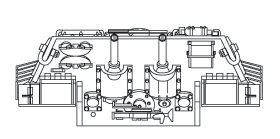 |
King-Tiger hull rear |
Les côtés du compartiment moteur accueillaient les réservoirs (518 litres chacun) et les radiateurs de refroidissement. Pour l'entretien standard, on pouvait accéder au moteur via la trappe du plateau arrière montée sur charnières ou la trappe boulonnée de la plaque arrière de la caisse pour atteindre le bas du moteur. Pour un entretient plus poussé, tout le plateau arrière pouvait être démonté et les éléments du compartiment enlevés.
The sides of the engine compartment accomodated the fuel tanks (518 liters each one) and the radiators of cooling. For standard maintenance, one could reach the engine via the hatch of the rear deck mounted on hinges or the bolted hatch of the back plate of the hull to reach the bottom of the engine. For one maintains more thorough, all rear deck could be dismounted and the elements of the compartment removed.
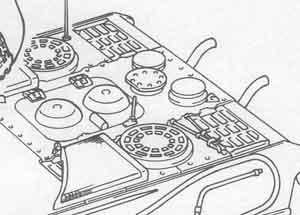 |
King-Tiger hull rear deck |
 |
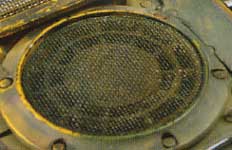 |
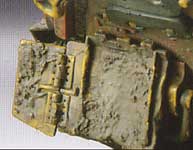 |
Engine |
One of the two engine ventilators |
Rear Mud-guard |
src: Forces of
Valor |
src: Forces of Valor |
src: Forces of Valor |
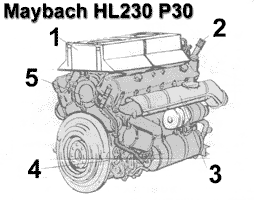 |
|
|
src: Academy
|
Les trains porteurs munis comme les modèles précédents de barres de torsions étaient également dotés de galets tout acier à haute résilience. Mais contrairement au Tigre I, l'interconnexion (imbrication) fut supprimée en raison des difficultés qu'elle entraînait lors de l'entretien et des nombreux blocages qu'elle provoquait.
The running gears provided like the preceding models with torsion bars were also equipped with any steel with high resilience road wheels. But contrary to Tiger I, the interconnection (imbrication) was removed because of the difficulties which it involved during maintenance and of many blockings that it caused.
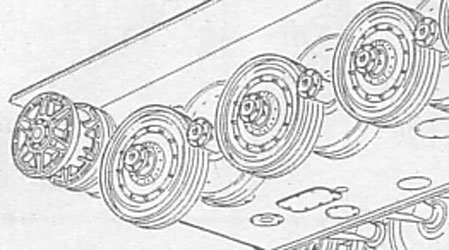 |
Disposition of the road wheels. |
Les 9 ensembles de galets doubles se recouvraient seulement partiellement. Comme pour le Tigre I deux jeux de chenilles furent utilisés, un pour la route et les transports (étroite), l'autre pour le combat (large).
The 9 sets of double road wheels overlapped only partially. As for Tiger I two sets of tracks were used, for the road and transport (narrow), the other for the combat (broad).
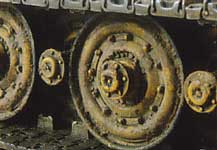 |
Steel road wheels |
src: Forces of Valor
|
Le Blindage en pente du Königstiger était assemblé par mortaises et soudures et était constitué de plaques de blindages homogènes en acier laminé. L'aspect général da la caisse était similaire à celle du Panther II sauf pour les jupes blindées caractéristiques du Tiger II.
The inclined Shielding of Königstiger was assembled by mortises and weldings and consisted of homogeneous armour-plates out of laminated steel. With if not the general aspect is identical to that of a Panther Ausf.G to share the armoured skirts characteristic of Tiger II.
 |
Red - 80mm
/ 69° Green - 80mm / 65° Orange - 80mm / 90° |
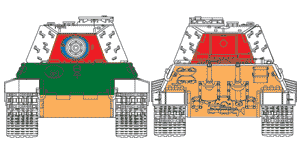 |
Red - 180mm / 81°
& 80mm/69° Blue - 100mm / Saukopf Green - 150mm / 40° Orange - 100mm / 40° & 80mm / 60° |
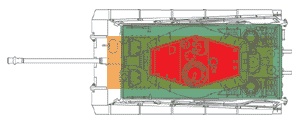 |
Red - 44mm / 0-12° Green - 40mm / 0° Orange - 25-40mm / 0° |
src: Vincent Bourguignon
|
Sources:
- Tiger in action, Armor Number 27 (squadron/signal publications, inc.)
- Connaissance de l'Histoire (Hachette) - N°17 - " Les chars de combat allemands 39-45"
- Connaissance de l'Histoire (Hachette) - N°5 - " Véhicules blindés allemands 39-45"
- Les Blindés de la Seconde Guerre Mondiale (Atlas)
- Kingtiger Heavy Tank 1942-1945 (Osprey Military) - New Vanguard N°1
- Site "Achtung Panzer" - http://www.achtungpanzer.com
- Site "Germany's vehicle history" - http://www.wwiivehicles.com
- Site "Second World War Armour" - http://www.onwar.com/tanks/index.htm